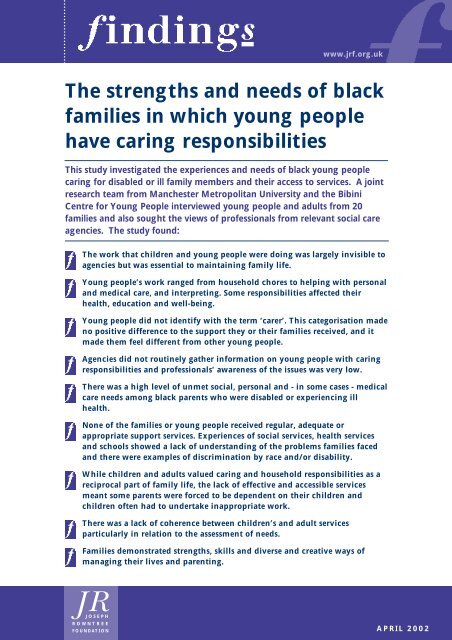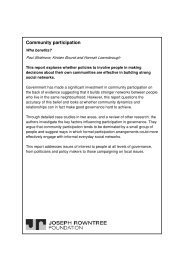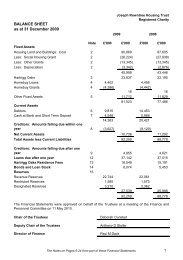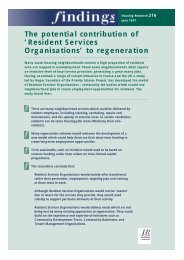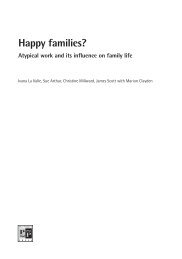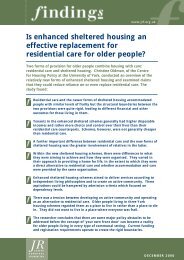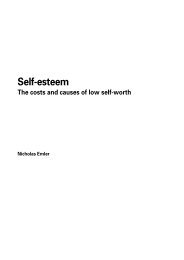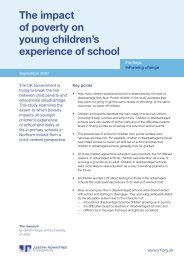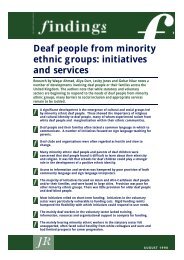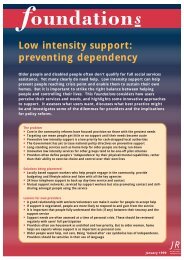The strengths and needs of black families in which young people ...
The strengths and needs of black families in which young people ...
The strengths and needs of black families in which young people ...
Create successful ePaper yourself
Turn your PDF publications into a flip-book with our unique Google optimized e-Paper software.
www.jrf.org.uk<br />
<strong>The</strong> <strong>strengths</strong> <strong>and</strong> <strong>needs</strong> <strong>of</strong> <strong>black</strong><br />
<strong>families</strong> <strong>in</strong> <strong>which</strong> <strong>young</strong> <strong>people</strong><br />
have car<strong>in</strong>g responsibilities<br />
This study <strong>in</strong>vestigated the experiences <strong>and</strong> <strong>needs</strong> <strong>of</strong> <strong>black</strong> <strong>young</strong> <strong>people</strong><br />
car<strong>in</strong>g for disabled or ill family members <strong>and</strong> their access to services. A jo<strong>in</strong>t<br />
research team from Manchester Metropolitan University <strong>and</strong> the Bib<strong>in</strong>i<br />
Centre for Young People <strong>in</strong>terviewed <strong>young</strong> <strong>people</strong> <strong>and</strong> adults from 20<br />
<strong>families</strong> <strong>and</strong> also sought the views <strong>of</strong> pr<strong>of</strong>essionals from relevant social care<br />
agencies. <strong>The</strong> study found:<br />
<strong>The</strong> work that children <strong>and</strong> <strong>young</strong> <strong>people</strong> were do<strong>in</strong>g was largely <strong>in</strong>visible to<br />
agencies but was essential to ma<strong>in</strong>ta<strong>in</strong><strong>in</strong>g family life.<br />
Young <strong>people</strong>’s work ranged from household chores to help<strong>in</strong>g with personal<br />
<strong>and</strong> medical care, <strong>and</strong> <strong>in</strong>terpret<strong>in</strong>g. Some responsibilities affected their<br />
health, education <strong>and</strong> well-be<strong>in</strong>g.<br />
Young <strong>people</strong> did not identify with the term ‘carer’. This categorisation made<br />
no positive difference to the support they or their <strong>families</strong> received, <strong>and</strong> it<br />
made them feel different from other <strong>young</strong> <strong>people</strong>.<br />
Agencies did not rout<strong>in</strong>ely gather <strong>in</strong>formation on <strong>young</strong> <strong>people</strong> with car<strong>in</strong>g<br />
responsibilities <strong>and</strong> pr<strong>of</strong>essionals’ awareness <strong>of</strong> the issues was very low.<br />
<strong>The</strong>re was a high level <strong>of</strong> unmet social, personal <strong>and</strong> - <strong>in</strong> some cases - medical<br />
care <strong>needs</strong> among <strong>black</strong> parents who were disabled or experienc<strong>in</strong>g ill<br />
health.<br />
None <strong>of</strong> the <strong>families</strong> or <strong>young</strong> <strong>people</strong> received regular, adequate or<br />
appropriate support services. Experiences <strong>of</strong> social services, health services<br />
<strong>and</strong> schools showed a lack <strong>of</strong> underst<strong>and</strong><strong>in</strong>g <strong>of</strong> the problems <strong>families</strong> faced<br />
<strong>and</strong> there were examples <strong>of</strong> discrim<strong>in</strong>ation by race <strong>and</strong>/or disability.<br />
While children <strong>and</strong> adults valued car<strong>in</strong>g <strong>and</strong> household responsibilities as a<br />
reciprocal part <strong>of</strong> family life, the lack <strong>of</strong> effective <strong>and</strong> accessible services<br />
meant some parents were forced to be dependent on their children <strong>and</strong><br />
children <strong>of</strong>ten had to undertake <strong>in</strong>appropriate work.<br />
<strong>The</strong>re was a lack <strong>of</strong> coherence between children’s <strong>and</strong> adult services<br />
particularly <strong>in</strong> relation to the assessment <strong>of</strong> <strong>needs</strong>.<br />
Families demonstrated <strong>strengths</strong>, skills <strong>and</strong> diverse <strong>and</strong> creative ways <strong>of</strong><br />
manag<strong>in</strong>g their lives <strong>and</strong> parent<strong>in</strong>g.<br />
JOSEPH<br />
ROWNTREE<br />
FOUNDATION APRIL 2002
APRIL 2002<br />
<strong>The</strong> significance <strong>of</strong> car<strong>in</strong>g<br />
While parents appreciated the focus on the <strong>needs</strong> <strong>of</strong><br />
their children that services set up for ‘<strong>young</strong> carers’<br />
provided, they did not regard their children as carers<br />
but as children who were <strong>in</strong>volved <strong>in</strong> provid<strong>in</strong>g<br />
support to <strong>people</strong> <strong>in</strong> the family. This dist<strong>in</strong>ction<br />
suggests that be<strong>in</strong>g a <strong>young</strong> carer is a role not an<br />
identity. Young <strong>people</strong> saw terms such as ‘carer’ <strong>and</strong><br />
‘cop<strong>in</strong>g’ as unhelpful: these terms carried<br />
connotations <strong>and</strong> expectations that placed pressures<br />
on <strong>young</strong> <strong>people</strong> <strong>and</strong> adults to cont<strong>in</strong>ue car<strong>in</strong>g<br />
without adequate support regardless <strong>of</strong> the effects<br />
upon them. <strong>The</strong>se terms were also seen as<br />
m<strong>in</strong>imis<strong>in</strong>g the contributions <strong>of</strong> disabled <strong>people</strong> to<br />
family life.<br />
Young <strong>people</strong>’s car<strong>in</strong>g activities had different<br />
purposes <strong>and</strong> mean<strong>in</strong>gs <strong>and</strong> their car<strong>in</strong>g roles had<br />
developed <strong>in</strong> relation to a range <strong>of</strong> different <strong>in</strong>fluences<br />
with<strong>in</strong> <strong>and</strong> outside <strong>families</strong>. Young <strong>people</strong> wanted<br />
recognition for look<strong>in</strong>g after others; they also found it<br />
hard to separate out their own <strong>needs</strong> from the <strong>needs</strong> <strong>of</strong><br />
family members who were important to them.<br />
Specific impairments or actual tasks were not<br />
<strong>in</strong>dicative <strong>of</strong> the impact <strong>of</strong> car<strong>in</strong>g on the <strong>young</strong><br />
person. While these were important, their<br />
significance was l<strong>in</strong>ked to other factors such as<br />
relationships <strong>in</strong> the family, skills <strong>and</strong> <strong>strengths</strong>, other<br />
sources <strong>of</strong> stress <strong>and</strong> k<strong>in</strong>ds <strong>of</strong> support available. (This<br />
raises questions about the provision <strong>of</strong> services on<br />
the basis <strong>of</strong> criteria such as ‘significant car<strong>in</strong>g<br />
responsibilities’, s<strong>in</strong>ce externally determ<strong>in</strong>ed<br />
def<strong>in</strong>itions <strong>of</strong> what is ‘significant’ tend to be fixed<br />
<strong>and</strong> do not usually take <strong>in</strong>to account contexts<br />
specific to <strong>families</strong> <strong>and</strong> <strong>in</strong>dividuals.)<br />
Young <strong>people</strong>’s work<br />
<strong>The</strong> chores, tasks <strong>and</strong> responsibilities taken on by<br />
children <strong>and</strong> <strong>young</strong> <strong>people</strong> varied greatly <strong>in</strong> terms <strong>of</strong><br />
the nature <strong>of</strong> tasks, levels <strong>of</strong> skill <strong>and</strong> physical<br />
strength required <strong>and</strong> time commitment. Gender,<br />
age, ability, the levels <strong>of</strong> support be<strong>in</strong>g provided by<br />
other adults <strong>and</strong> pr<strong>of</strong>essionals, <strong>and</strong> the particular<br />
expectations <strong>and</strong> dynamics <strong>of</strong> <strong>in</strong>dividual <strong>families</strong><br />
were also important factors. Although not a specific<br />
focus <strong>of</strong> the study, there was no evidence that<br />
children <strong>and</strong> <strong>young</strong> <strong>people</strong>’s car<strong>in</strong>g roles were<br />
determ<strong>in</strong>ed on the basis <strong>of</strong> cultural expectations.<br />
Where <strong>young</strong> <strong>people</strong> were <strong>in</strong> situations <strong>and</strong><br />
undertak<strong>in</strong>g tasks that they found difficult or overly<br />
dem<strong>and</strong><strong>in</strong>g, this affected education, relationships<br />
with peers <strong>and</strong> social life. Some <strong>young</strong> <strong>people</strong> had<br />
developed ways <strong>of</strong> deal<strong>in</strong>g with these stresses, such as<br />
work<strong>in</strong>g extra hard with schoolwork so that they<br />
would not fall beh<strong>in</strong>d. <strong>The</strong>re was a tendency by some<br />
adults to see children’s car<strong>in</strong>g role only <strong>in</strong> positive<br />
terms whereas some <strong>young</strong> <strong>people</strong> clearly felt that<br />
some <strong>of</strong> their car<strong>in</strong>g responsibilities had a negative<br />
impact upon them. Parents were particularly aware <strong>of</strong><br />
the impact <strong>of</strong> stress <strong>and</strong> anxiety caused by the<br />
situation, both on themselves <strong>and</strong> their children.<br />
<strong>The</strong> work that children <strong>and</strong> <strong>young</strong> <strong>people</strong> were<br />
do<strong>in</strong>g <strong>in</strong>cluded: clean<strong>in</strong>g; iron<strong>in</strong>g; garden<strong>in</strong>g;<br />
cook<strong>in</strong>g <strong>and</strong> prepar<strong>in</strong>g meals <strong>and</strong> dr<strong>in</strong>ks; shopp<strong>in</strong>g;<br />
deal<strong>in</strong>g with f<strong>in</strong>ances; assist<strong>in</strong>g <strong>people</strong> with mobility;<br />
help<strong>in</strong>g with personal care; medical care; help<strong>in</strong>g<br />
<strong>people</strong> to dress; encourag<strong>in</strong>g <strong>people</strong> to exercise <strong>and</strong><br />
to socialise; supervis<strong>in</strong>g <strong>and</strong> play<strong>in</strong>g with children;<br />
tak<strong>in</strong>g children to <strong>and</strong> from school; be<strong>in</strong>g available<br />
<strong>in</strong> case <strong>people</strong> need assistance; translat<strong>in</strong>g <strong>and</strong><br />
<strong>in</strong>terpret<strong>in</strong>g; help<strong>in</strong>g <strong>people</strong> to learn English;<br />
build<strong>in</strong>g <strong>people</strong>’s confidence.<br />
Responses <strong>of</strong> social care agencies<br />
Social care agencies did not gather <strong>in</strong>formation about<br />
<strong>black</strong> <strong>young</strong> <strong>people</strong> with car<strong>in</strong>g responsibilities <strong>and</strong> it<br />
was therefore impossible to determ<strong>in</strong>e the numbers<br />
<strong>of</strong> <strong>black</strong> children <strong>and</strong> <strong>young</strong> <strong>people</strong> provid<strong>in</strong>g<br />
support to disabled parents <strong>and</strong> other relatives. Other<br />
studies <strong>in</strong>dicate, however, that <strong>black</strong> <strong>young</strong> <strong>people</strong><br />
are more likely to be <strong>in</strong>volved <strong>in</strong> <strong>in</strong>formal car<strong>in</strong>g<br />
arrangements than other <strong>young</strong> <strong>people</strong>.<br />
<strong>The</strong> k<strong>in</strong>ds <strong>of</strong> services that would have made a<br />
difference to <strong>families</strong>’ lives were health-based services<br />
(e.g. accessible facilities <strong>in</strong> their homes, support with<br />
adm<strong>in</strong>ister<strong>in</strong>g medication, <strong>in</strong>formation <strong>and</strong> advice<br />
on deal<strong>in</strong>g with illnesses, <strong>in</strong>terpreters), good quality<br />
home care services, counsell<strong>in</strong>g <strong>and</strong> social activity<br />
services for children <strong>and</strong> also for <strong>families</strong>, social work<br />
support geared to empower<strong>in</strong>g all members <strong>of</strong><br />
<strong>families</strong> <strong>and</strong> appropriate educational support <strong>and</strong><br />
<strong>in</strong>creased underst<strong>and</strong><strong>in</strong>g among schools.<br />
While <strong>young</strong> <strong>people</strong> identified these services as<br />
appropriate, no <strong>families</strong> <strong>in</strong> the study were actually<br />
receiv<strong>in</strong>g such support. For example, where <strong>young</strong><br />
<strong>black</strong> boys had car<strong>in</strong>g responsibilities that affected<br />
their behaviour <strong>and</strong> progress at school, this was more<br />
likely to result <strong>in</strong> their exclusion from school rather<br />
than any other response.<br />
<strong>The</strong> study po<strong>in</strong>ted up a number <strong>of</strong> specific<br />
reasons for the lack <strong>of</strong> appropriate responses by social<br />
care agencies:<br />
• Invisibility - among pr<strong>of</strong>essional workers (social<br />
services, health-based staff <strong>and</strong> workers from<br />
voluntary organisations), <strong>young</strong> <strong>people</strong> with<br />
car<strong>in</strong>g responsibilities seemed to be <strong>in</strong>visible.<br />
<strong>The</strong>re was no acknowledgement <strong>of</strong> the support<br />
that they provided <strong>and</strong>, even <strong>in</strong> cases <strong>in</strong> <strong>which</strong> a<br />
<strong>young</strong> person was clearly the sole carer for a<br />
disabled parent, questions were not asked about<br />
their <strong>needs</strong> or about the <strong>needs</strong> <strong>of</strong> their parent (or<br />
other disabled/ill family member) for support with
APRIL 2002<br />
personal assistance, parent<strong>in</strong>g tasks etc.<br />
• Record-keep<strong>in</strong>g <strong>and</strong> monitor<strong>in</strong>g - both statutory<br />
<strong>and</strong> generic voluntary agencies did not<br />
systematically record <strong>and</strong> monitor the ethnicity <strong>of</strong><br />
service users even where they had a policy<br />
requir<strong>in</strong>g them to do so. <strong>The</strong>re were <strong>in</strong>dications <strong>of</strong><br />
a cont<strong>in</strong>u<strong>in</strong>g sense <strong>of</strong> unease <strong>in</strong> record<strong>in</strong>g<br />
<strong>in</strong>formation about ethnicity, race, religion <strong>and</strong><br />
language, despite the fact that without such<br />
<strong>in</strong>formation it was impossible for service providers<br />
to see if <strong>black</strong> <strong>people</strong> were under-represented<br />
with<strong>in</strong> an agency’s client base <strong>and</strong> to plan for<br />
appropriate services. In contrast, however, <strong>black</strong><br />
organisations were rout<strong>in</strong>ely record<strong>in</strong>g <strong>and</strong><br />
monitor<strong>in</strong>g ethnicity even if they did not have a<br />
policy requir<strong>in</strong>g them to do so. This was despite<br />
the fact that they were less likely to have the<br />
<strong>in</strong>frastructure <strong>and</strong> resources to undertake<br />
systematic monitor<strong>in</strong>g. <strong>The</strong> study suggests there is<br />
a need for a more flexible <strong>and</strong> participative<br />
approach to record<strong>in</strong>g ethnicity <strong>and</strong> for provid<strong>in</strong>g<br />
clear evidence to communities about the use <strong>of</strong><br />
such <strong>in</strong>formation.<br />
• Parental fears - parents were <strong>of</strong>ten reluctant to<br />
approach the local authority, fear<strong>in</strong>g that children<br />
would be assessed as ‘<strong>in</strong> need’ with connotations<br />
<strong>of</strong> <strong>in</strong>adequate parent<strong>in</strong>g. In some <strong>families</strong>, <strong>needs</strong><br />
<strong>and</strong> hardship were significantly under-reported to<br />
agencies, such was the concern that children<br />
might be removed from <strong>families</strong>.<br />
• Inadequate responses - where <strong>families</strong> did ask for<br />
help this was not always provided <strong>and</strong> sometimes<br />
there was no response at all from the local<br />
authority. In <strong>families</strong> where an element <strong>of</strong> risk had<br />
been identified for children, the social services<br />
department did become <strong>in</strong>volved; however, the<br />
focus was around child protection <strong>and</strong> did not<br />
result <strong>in</strong> the provision <strong>of</strong> services to support<br />
parent<strong>in</strong>g or reduce children’s car<strong>in</strong>g<br />
responsibilities.<br />
• Inappropriate responses - <strong>families</strong> sometimes<br />
preferred their own children to provide care<br />
because services from the local authority <strong>and</strong><br />
voluntary organisations did not take <strong>in</strong>to account<br />
the significance <strong>of</strong> cultural <strong>and</strong> religious <strong>needs</strong>.<br />
Other <strong>families</strong> had concerns about ma<strong>in</strong>stream<br />
<strong>young</strong> carers’ services because they felt these<br />
negated the importance <strong>of</strong> their children’s racial<br />
identity or operated criteria that excluded<br />
members <strong>of</strong> the family. In contrast, <strong>families</strong> were<br />
very positive about the services provided by the<br />
Black Young Carers’ Project (although this service<br />
had been discont<strong>in</strong>ued).<br />
• Poor quality services - <strong>in</strong> all but one case, <strong>families</strong><br />
that had been provided with home care services<br />
reported negative experiences. This was both<br />
because services were discont<strong>in</strong>ued despite<br />
ongo<strong>in</strong>g need <strong>and</strong> also because <strong>of</strong> the st<strong>and</strong>ard <strong>of</strong><br />
services, <strong>which</strong> <strong>in</strong> all cases were described as very<br />
poor. Home care services had been contracted out<br />
to private agencies <strong>and</strong> <strong>families</strong> felt that the<br />
st<strong>and</strong>ards were not monitored. In the one case<br />
where a family had benefited from good quality<br />
home care support, this was because the disabled<br />
mother had arranged it herself us<strong>in</strong>g direct<br />
payments.<br />
• Lack <strong>of</strong> assessment - there was a fail<strong>in</strong>g on the<br />
part <strong>of</strong> local authorities to undertake assessments<br />
both <strong>of</strong> the support <strong>needs</strong> (<strong>in</strong>clud<strong>in</strong>g parent<strong>in</strong>g<br />
support <strong>needs</strong>) <strong>of</strong> disabled parents <strong>and</strong> also <strong>of</strong> the<br />
<strong>needs</strong> <strong>of</strong> <strong>young</strong> <strong>people</strong> <strong>in</strong> relation to their car<strong>in</strong>g<br />
responsibilities. None <strong>of</strong> the parents <strong>and</strong> <strong>young</strong><br />
<strong>people</strong> had been comprehensively assessed for<br />
their support <strong>needs</strong> by statutory agencies <strong>of</strong>fer<strong>in</strong>g<br />
support.<br />
• Lack <strong>of</strong> coherence at policy level - the study<br />
po<strong>in</strong>ted up the need for greater coherence between<br />
children’s <strong>and</strong> adult services, particularly <strong>in</strong><br />
relation to the assessment <strong>of</strong> <strong>needs</strong>. For some<br />
<strong>families</strong> assessments us<strong>in</strong>g <strong>The</strong> framework for the<br />
assessment <strong>of</strong> children <strong>in</strong> need (DoH 2000)<br />
seemed appropriate (although the study also<br />
highlighted some concerns about this approach).<br />
For others, it seemed more relevant to use<br />
procedures developed out <strong>of</strong> policy <strong>and</strong> legislation<br />
on carers. Young <strong>people</strong> <strong>and</strong> their <strong>families</strong> saw a<br />
flexible approach as be<strong>in</strong>g more likely to meet<br />
diverse <strong>needs</strong> <strong>and</strong> respect <strong>in</strong>dividual family wishes.<br />
Identities, family life <strong>and</strong> communities<br />
<strong>The</strong> study also exam<strong>in</strong>ed how <strong>families</strong> felt their<br />
experiences were affected by their ethnic <strong>and</strong> cultural<br />
identity:<br />
• Religion - this was a significant aspect <strong>of</strong> most<br />
family’s lives. Religious communities <strong>of</strong>ten<br />
provided practical support <strong>and</strong> helped to keep<br />
<strong>families</strong> together. However, some <strong>people</strong>’s<br />
opportunities to practice religion were restricted by<br />
discrim<strong>in</strong>ation aga<strong>in</strong>st disabled <strong>people</strong>, most<br />
notably <strong>in</strong>accessible places <strong>of</strong> worship <strong>and</strong> the<br />
attitudes <strong>of</strong> other <strong>people</strong>.<br />
• Language - most <strong>of</strong> the <strong>families</strong> were fluent <strong>in</strong><br />
English as well as other languages. Where parents<br />
did not speak English, children were <strong>of</strong>ten required<br />
to act as <strong>in</strong>terpreters. Some <strong>young</strong> <strong>people</strong> were<br />
skilled <strong>in</strong> this role, however, there were examples <strong>in</strong><br />
<strong>which</strong> it was <strong>in</strong>appropriate <strong>and</strong> created difficulties,<br />
particularly if the child was very <strong>young</strong> or if the<br />
<strong>in</strong>formation was <strong>of</strong> a complex or sensitive nature.<br />
• Ethnicity - <strong>black</strong> <strong>young</strong> <strong>people</strong> <strong>and</strong> <strong>families</strong><br />
described their ethnicity <strong>in</strong> creative <strong>and</strong> productive
APRIL 2002<br />
ways <strong>and</strong> discussed this issue with confidence <strong>and</strong><br />
pride. However, their experiences <strong>of</strong> the ways <strong>in</strong><br />
<strong>which</strong> their ethnicity was understood or<br />
represented was that it was <strong>of</strong>ten distorted or<br />
reduced to fit <strong>in</strong> with the requirements <strong>of</strong> service<br />
providers.<br />
• Families - <strong>families</strong> were diverse <strong>and</strong> reflected a<br />
broad <strong>and</strong> <strong>in</strong>clusive concept <strong>of</strong> family, based on<br />
k<strong>in</strong>ship networks <strong>of</strong> reciprocal care, support <strong>and</strong><br />
responsibility, <strong>in</strong>clud<strong>in</strong>g both biological <strong>and</strong> nonbiological<br />
relationships <strong>and</strong> encompass<strong>in</strong>g <strong>families</strong><br />
whose members lived apart but carried out these<br />
functions, as well as households <strong>in</strong> <strong>which</strong> <strong>people</strong><br />
lived together. <strong>The</strong> extent to <strong>which</strong> extended<br />
family members provided support to households<br />
where there was a disabled parent (where this was<br />
preferred), poverty <strong>and</strong> other social problems<br />
fac<strong>in</strong>g some <strong>black</strong> <strong>families</strong> underm<strong>in</strong>ed their<br />
attempts to do so.<br />
• Parent<strong>in</strong>g - while there were similarities between<br />
current social work notions <strong>of</strong> parent<strong>in</strong>g, there<br />
were also significant differences. Families’<br />
underst<strong>and</strong><strong>in</strong>gs <strong>of</strong> parent<strong>in</strong>g were broad <strong>and</strong><br />
creative. Some parents met their children’s<br />
emotional, physical, educational <strong>and</strong> other <strong>needs</strong><br />
directly themselves; sometimes these<br />
responsibilities were shared between different<br />
adults. Decisions about children’s <strong>and</strong> <strong>young</strong><br />
<strong>people</strong>’s <strong>in</strong>volvement <strong>in</strong> car<strong>in</strong>g were based on the<br />
adult’s ability to exercise parent<strong>in</strong>g<br />
responsibilities, by negotiation with<strong>in</strong> the family,<br />
rather than be<strong>in</strong>g due to an absence <strong>of</strong> parent<strong>in</strong>g.<br />
• Community - the way <strong>in</strong> <strong>which</strong> <strong>people</strong><br />
experienced their local community was likely to be<br />
refracted through experiences <strong>of</strong> discrim<strong>in</strong>ation<br />
aga<strong>in</strong>st disabled <strong>people</strong> <strong>and</strong> other forms <strong>of</strong> social<br />
exclusion. In each <strong>of</strong> the ma<strong>in</strong> neighbourhoods<br />
where participants lived some felt unsafe <strong>in</strong> the<br />
area, while others found their local community<br />
supportive. A range <strong>of</strong> external stresses affected<br />
family life. <strong>The</strong>se <strong>in</strong>cluded poverty, racial<br />
harassment, religious bigotry, isolation from<br />
support services, <strong>in</strong>appropriate or oppressive<br />
services, anxiety about the <strong>in</strong>volvement <strong>of</strong> social<br />
services, serious long-term illness, <strong>and</strong> stress l<strong>in</strong>ked<br />
to liv<strong>in</strong>g with one’s own, or a family member’s,<br />
long-term mental health problems. <strong>The</strong>re were<br />
also problems deal<strong>in</strong>g with the effects <strong>of</strong> domestic<br />
violence, school exclusion, crime <strong>and</strong> violence.<br />
over 12 months <strong>and</strong> <strong>in</strong>volved consultation events<br />
with 13 <strong>young</strong> <strong>people</strong>; tra<strong>in</strong><strong>in</strong>g <strong>of</strong> three ‘<strong>young</strong><br />
carers’ as peer researchers; <strong>in</strong>terviews with 17 <strong>young</strong><br />
<strong>people</strong> <strong>and</strong> 15 family members from 20 <strong>families</strong> (the<br />
<strong>families</strong> were diverse <strong>in</strong> terms <strong>of</strong> ethnicity <strong>and</strong><br />
religion); questionnaires from 40 agencies <strong>and</strong><br />
discussions with 15 practitioners <strong>and</strong> managers from<br />
particular organisations (e.g. <strong>young</strong> carers projects,<br />
social services teams, voluntary organisations <strong>and</strong><br />
health-based organisations).<br />
How to get further <strong>in</strong>formation<br />
Further <strong>in</strong>formation about the study is available from<br />
<strong>The</strong> Bib<strong>in</strong>i Centre for Young People, 60A Wood Road,<br />
Whalley Range, Manchester M16 8BL, Tel: 0161 881<br />
8558, Fax: 0161 882 0420, email:<br />
<strong>in</strong>formation@bib<strong>in</strong>icentre.fsnet.co.uk.<br />
<strong>The</strong> full report, Invisible <strong>families</strong>: <strong>The</strong> <strong>strengths</strong> <strong>and</strong><br />
<strong>needs</strong> <strong>of</strong> Black <strong>families</strong> <strong>in</strong> <strong>which</strong> <strong>young</strong> <strong>people</strong> have<br />
car<strong>in</strong>g responsibilities by Adele Jones, Dharman<br />
Jeyas<strong>in</strong>gham <strong>and</strong> Sita Rajasooriya, is published for the<br />
Foundation by <strong>The</strong> Policy Press (ISBN 1 86134 388 4,<br />
price £12.95).<br />
About the project<br />
This was a study by the Bib<strong>in</strong>i Centre for Young<br />
People <strong>in</strong> collaboration with the Manchester<br />
Metropolitan University. <strong>The</strong> study was carried out<br />
JOSEPH<br />
ROWNTREE<br />
FOUNDATION<br />
Published by the<br />
Joseph Rowntree Foundation<br />
<strong>The</strong> Homestead, 40 Water End, York YO30 6WP<br />
Tel: 01904 629241 Fax: 01904 620072<br />
http://www.jrf.org.uk<br />
ISSN 0958-3084<br />
<strong>The</strong> Joseph Rowntree Foundation is an <strong>in</strong>dependent,<br />
non-political body <strong>which</strong> has supported this project as<br />
part <strong>of</strong> its programme <strong>of</strong> research <strong>and</strong> <strong>in</strong>novative<br />
development projects, <strong>which</strong> it hopes will be <strong>of</strong> value<br />
to policy-makers, practitioners <strong>and</strong> service users. <strong>The</strong><br />
f<strong>in</strong>d<strong>in</strong>gs presented here, however, are those <strong>of</strong> the<br />
authors <strong>and</strong> not necessarily those <strong>of</strong> the Foundation.<br />
412


